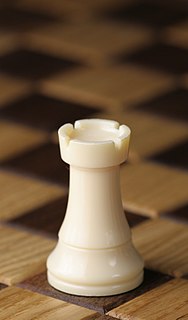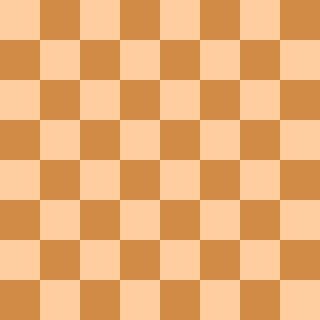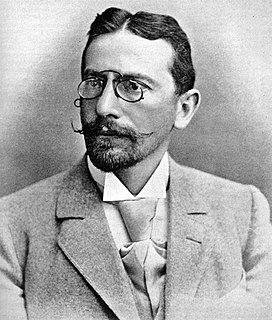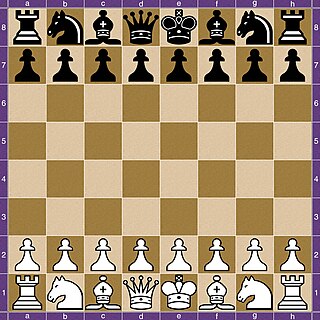
Aron Nimzowitsch was a Latvian-born Danish chess player and writer. He was the foremost figure amongst the hypermoderns and wrote a very influential book on chess theory: My System. In the late 1920s, he was one of the best chess players in the world.

Chess is a board game played between two players. It is sometimes called Western chess, or international chess to distinguish it from related games such as xiangqi. The current form of the game emerged in Southern Europe during the second half of the 15th century after evolving from the medieval game of Shatranj (Arabic) or chatrang (Persian), which in turn evolved from the ancient Indian game, Chaturanga. Today, chess is one of the world's most popular games, played by millions of people worldwide.
Chess strategy is the aspect of chess play concerned with evaluation of chess positions and setting of goals and long-term plans for future play. While evaluating a position strategically, a player must take into account such factors as the relative value of the pieces on the board, pawn structure, king safety, position of pieces, and control of key squares and groups of squares. Chess strategy is distinguished from chess tactics, which is the aspect of play concerned with the move-by-move setting up of threats and defenses. Some authors distinguish static strategic imbalances, which tend to persist for many moves, from dynamic imbalances, which are temporary. This distinction affects the immediacy with which a sought-after plan should take effect. Until players reach the skill level of "master", chess tactics tend to ultimately decide the outcomes of games more often than strategy does. Many chess coaches thus emphasize the study of tactics as the most efficient way to improve one's results in serious chess play.

The rook is a piece in the game of chess resembling a castle. Formerly the piece was alternatively called the tower, marquess, rector, and comes. The term castle is considered to be informal, incorrect, or old-fashioned.

A chess piece, or chessman, is any of the six different types of movable objects used on a chessboard to play the game of chess.

The rules of chess are rules governing the play of the game of chess. While the exact origins of chess are unclear, modern rules first took form during the Middle Ages. The rules continued to be slightly modified until the early 19th century, when they reached essentially their current form. The rules also varied somewhat from place to place. Today, the standard rules are set by FIDE, the international governing body for chess. Slight modifications are made by some national organizations for their own purposes. There are variations of the rules for fast chess, correspondence chess, online chess, and Chess960.
This glossary of chess explains commonly used terms in chess, in alphabetical order. Some of these terms have their own pages, like fork and pin. For a list of unorthodox chess pieces, see Fairy chess piece; for a list of terms specific to chess problems, see Glossary of chess problems; for a list of named opening lines, see List of chess openings; for a list of chess-related games, see List of chess variants.

The Lucena position is one of the most famous and important positions in chess endgame theory, where one side has a rook and a pawn and the defender has a rook. It is fundamental in the rook and pawn versus rook endgame. If the side with the pawn can reach this type of position, they can forcibly win the game. Most rook and pawn versus rook endgames reach either the Lucena position or the Philidor position if played accurately. The side with the pawn will try to reach the Lucena position to win; the other side will try to reach the Philidor position to draw.

The middlegame in chess is the portion of the game in between the opening and the endgame, though there is no clear line between the opening and middlegame or between the middlegame and endgame. The middlegame begins when both players have completed the development of all or most of their pieces and the king has been brought to relative safety. However, at master level, the opening analysis may go well into the middlegame.
In chess, the fianchetto is a pattern of development wherein a bishop is developed to the second rank of the adjacent b- or g-file, the knight pawn having been moved one or two squares forward.

Hypermodernism is a school of chess that emerged after World War I. It featured challenges to the chess ideas of central European masters, including Wilhelm Steinitz's approach to the centre and the rules established by Siegbert Tarrasch.

In chess, a passed pawn is a pawn with no opposing pawns to prevent it from advancing to the eighth rank; i.e. there are no opposing pawns in front of it on either the same file or adjacent files. A passed pawn is sometimes colloquially called a passer. Passed pawns can be an advantage because only the opponent's pieces can stop them from promoting.

In chess, an isolated pawn is a pawn that has no friendly pawn on an adjacent file. Isolated pawns are usually a weakness because they cannot be protected by other pawns. The square in front of the pawn may become a good outpost or otherwise a good square for the opponent to anchor pieces. Isolated pawns most often become weaker in the endgame, as there are fewer pieces available to protect the pawn.

An outpost is a square on the fourth, fifth, sixth, or seventh rank which is protected by a pawn and which cannot be attacked by an opponent's pawn. Such a square is a hole for the opponent. In the figure to the right, c4 is an outpost, occupied by White's knight. It cannot be attacked by Black's pawns – there is no pawn on the d-file and Black's pawn on the b-file is too far advanced.

The Tarrasch rule is a general principle that applies in the majority of chess middlegames and endgames. Siegbert Tarrasch (1862–1934) stated the "rule" that rooks should be placed behind passed pawns – either the player's or the opponent's. The idea behind the guideline is that (1) if a player's rook is behind his passed pawn, the rook protects it as it advances, and (2) if it is behind an opponent's passed pawn, the pawn cannot advance unless it is protected along its way.

In the game of chess, prophylaxis or a prophylactic move is a move that stops the opponent from taking action in a certain area for fear of some type of reprisal. Prophylactic moves are aimed at not just improving one's position, but preventing the opponent from improving their own. Perhaps the most common prophylactic idea is the advance of the rook pawn near a castled king to make luft averting the possibility of a back rank checkmate, or to prevent pins.
The exchange in chess refers to a situation in which one player exchanges a minor piece for a rook. The side which wins the rook is said to have won the exchange, while the other player has lost the exchange, since the rook is usually more valuable. Alternatively, the side that has won the rook is up the exchange, and the other player is down the exchange. The opposing captures often happen on consecutive moves, although this is not strictly necessary. It is generally detrimental to lose the exchange, although occasionally one may find reason to purposely do so; the result is an exchange sacrifice. The minor exchange is an uncommon term for the exchange of a bishop and knight.

The game of chess is commonly divided into three phases: the opening, middlegame, and endgame. There is a large body of theory regarding how the game should be played in each of these phases, especially the opening and endgame. Those who write about chess theory, who are often also eminent players, are referred to as "theorists" or "theoreticians".

The following outline is provided as an overview of and topical guide to chess:









